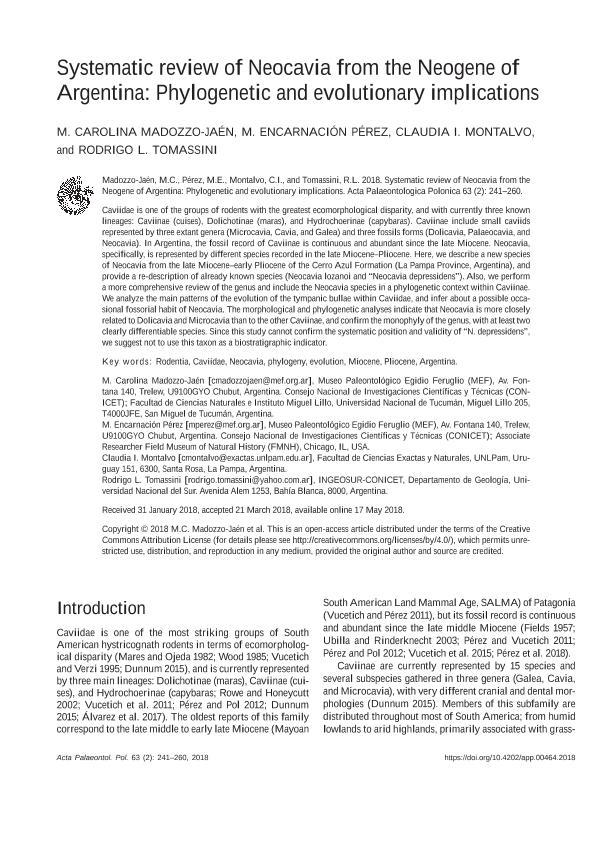Artículo
Systematic review of Neocavia from the Neogene of Argentina: Phylogenetic and evolutionary implications
Madozzo Jaén, María Carolina ; Pérez, María Encarnación
; Pérez, María Encarnación ; Montalvo, Claudia Inés; Tomassini, Rodrigo Leandro
; Montalvo, Claudia Inés; Tomassini, Rodrigo Leandro
 ; Pérez, María Encarnación
; Pérez, María Encarnación ; Montalvo, Claudia Inés; Tomassini, Rodrigo Leandro
; Montalvo, Claudia Inés; Tomassini, Rodrigo Leandro
Fecha de publicación:
05/2018
Editorial:
Polish Academy of Sciences. Institute of Paleobiology
Revista:
Acta Palaeontologica Polonica
ISSN:
0567-7920
e-ISSN:
1732-2421
Idioma:
Inglés
Tipo de recurso:
Artículo publicado
Clasificación temática:
Resumen
Caviidae is one of the groups of rodents with the greatest ecomorphological disparity, and with currently three known lineages: Caviinae (cuises), Dolichotinae (maras), and Hydrochoerinae (capybaras). Caviinae include small caviids represented by three extant genera (Microcavia, Cavia, and Galea) and three fossils forms (Dolicavia, Palaeocavia, and Neocavia). In Argentina, the fossil record of Caviinae is continuous and abundant since the late Miocene. Neocavia, specifically, is represented by different species recorded in the late Miocene-Pliocene. Here, we describe a new species of Neocavia from the late Miocene-early Pliocene of the Cerro Azul Formation (La Pampa Province, Argentina), and provide a re-description of already known species (Neocavia lozanoi and “Neocavia depressidens”). Also, we perform a more comprehensive review of the genus and include the Neocavia species in a phylogenetic context within Caviinae. We analyze the main patterns of the evolution of the tympanic bullae within Caviidae, and infer about a possible occasional fossorial habit of Neocavia. The morphological and phylogenetic analyses indicate that Neocavia is more closely related to Dolicavia and Microcavia than to the other Caviinae, and confirm the monophyly of the genus, with at least two clearly differentiable species. Since this study cannot confirm the systematic position and validity of “N. depressidens”, we suggest not to use this taxon as a biostratigraphic indicator.
Palabras clave:
Argentina
,
Caviidae
,
Evolution
,
Miocene
,
Neocavia
,
Phylogeny
,
Pliocene
,
Rodentia
Archivos asociados
Licencia
Identificadores
Colecciones
Articulos(INGEOSUR)
Articulos de INST.GEOLOGICO DEL SUR
Articulos de INST.GEOLOGICO DEL SUR
Citación
Madozzo Jaén, María Carolina; Pérez, María Encarnación; Montalvo, Claudia Inés; Tomassini, Rodrigo Leandro; Systematic review of Neocavia from the Neogene of Argentina: Phylogenetic and evolutionary implications; Polish Academy of Sciences. Institute of Paleobiology; Acta Palaeontologica Polonica; 63; 2; 5-2018; 241-260
Compartir
Altmétricas



